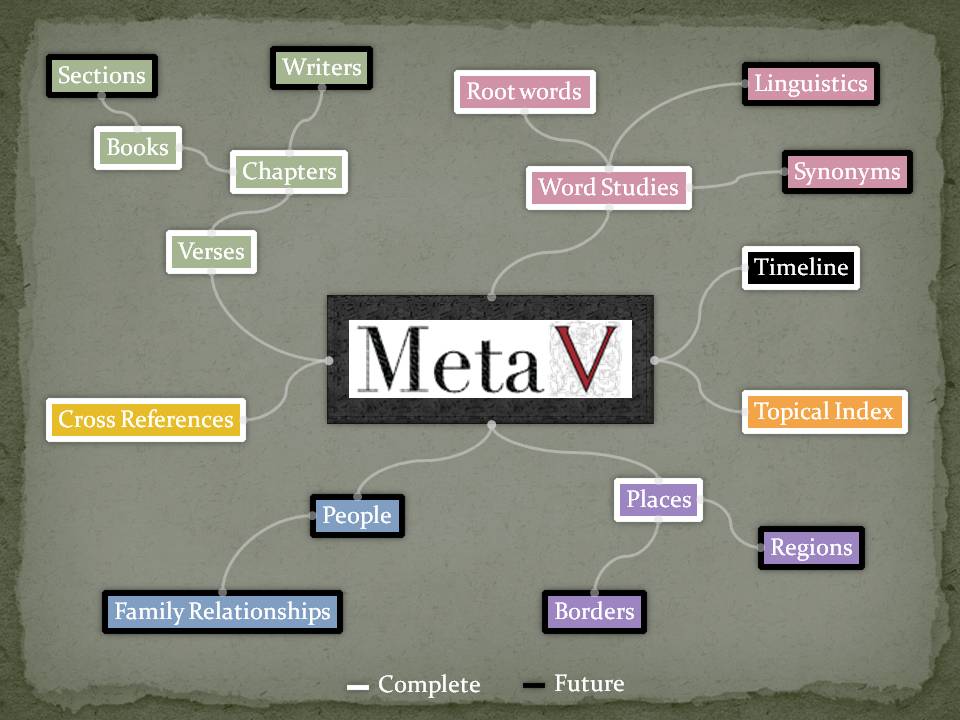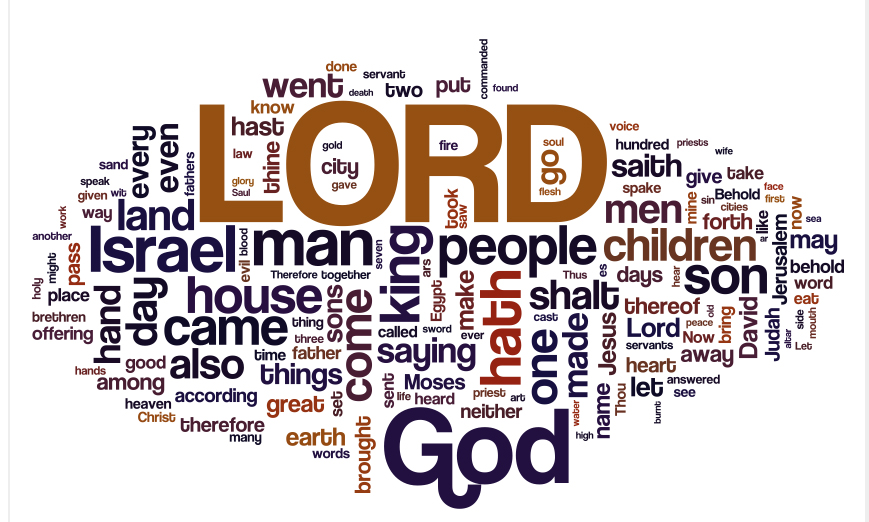It’s easy to think that the “King James Only” movement is limited to the English-speaking Western world. A Principal at Far Eastern Bible College in Singapore explains why it goes beyond that, and how the mainline trend can be characterized as “multiversions-onlyism.”
Category: The Bible
Progress Update
A lot has progressed since I first posted the central parts of MetaV. At that time, I had only converted and indexed the text of the Bible itself. Since then, I’ve managed to add cross references, topics, time lines, readability info, Strong’s Concordance, and locations. I’ve even made a number of tools to explore each “module,” and one to explore the timeline, places, and text all in one place. But, what’s next? The diagram below shows the modules I have envisioned so far to include in the database. Black outlines indicate areas of future development; white outlines are completed modules (tables).
Each sub-group has at least the main part of it complete, with one exception: People. What can I say? People are messy. I know there are a number of genealogies out there and a number of tools produced to explore them, but finding an openly available one in an appropriately structured file that’s free for public use is proving difficult. Therefore, I expect it will take significantly longer to compile such a reference on my own using what I’ve scraped together so far.
I have chosen not to upload the updated database until I at least have people identified and tagged with basic relationship information (father/son, husband/wife). After that iteration is complete, I’ll make that available and begin work on the remaining modules and other refinements at the same time as producing new, simple tools to explore the database. Any estimate on how long that will take would only be a guess.
Introducing MetaV

I’ve spent some time already on this blog talking about the ideas behind MetaV: what it is, why it’s different, etc. Now, the map and timeline data is complete and the first visual exploration tool is here. This work is not licensed, so feel free to share, copy, and modify as you wish.
It’s about time!

One central idea behind this new tool called MetaV is to link everything in the Bible to a period of time, then use that to perform a search or put a passage in greater context. Today, this is one step closer to being real.
R.A. Torrey compiled the Treasury of Scripture knowledge which contains the most cross-references of any concordance available. It also contains a year associated with each passage. I have taken this data and plotted it along a timeline (below) in a way that I believe will be simple to understand and use when combined with other panes of information.

The concept comes from atomic mass spectroscopy. A simple strip with bars on it of varying colors or line densities indicates particular wavelengths of an element.
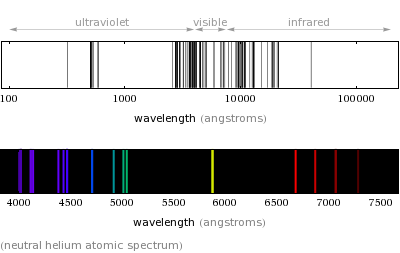
The same layout can be used for a timeline, substituting years for wavelengths and verses for particles of light where BC is denoted with a negative number and the darkness of the color indicates how many verses deal with that year, as seen above.
This graphic is based on Torrey’s book, but in its electronic form it must be checked for data quality and completeness before being incorporated into anything more detailed. The simplicity of such a view, when combined with details from associated passages and other useful information has a real potential to make a complex, interrelated whole more understandable.
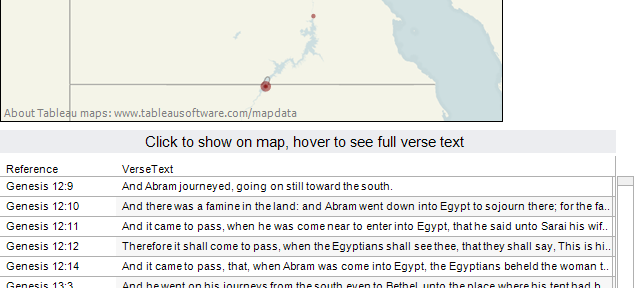
With the recent uprising in Egypt, I thought it would be worthwhile to get a little historical context. What better place to go than the Bible? Take a look at this interactive map to see all the places in modern-day Egypt that are mentioned in the Bible.
Quality Interaction
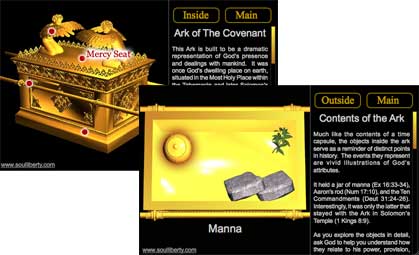
I’ve been out shopping for cars recently, and it has reminded me of one of the shortcomings I’ve noticed among Christian websites I tend to visit. As usual, I intend to fill this gap through our efforts at SoulLiberty.com. Let me explain.
Something I appreciate about car websites is that they put a lot of effort into showing you the main features of each model. I can see the inside and outside, and often do a 360-degree tour. In each view, I can see certain areas featured; click on them and find out more details, see a video, etc. Of course, a lot of this is designed to dazzle the buyer into an emotional state where he simply must have that car becuause “it’s just so cool!”
But aren’t certain things about the Bible just “so cool?” I happen to think so. Then, why not present things in such a way that conveys that feeling to the new or maturing Christian student? If a storytelling professor can make statistics look like the most interesting thing in the world, can’t geeky web designers do the same with the most epic and fascinating story of all time?
Guttenberg invented the printing press for one big reason: to distribute the Bible to as many people as possible. That was a time when Christians were the master of new technology intended to carry out God’s calling. Today, the most high-tech ideas are motivated by material gain or fulfilling other carnal lusts. How can we begin to turn this back around?
One place to start is by implementing today’s technology to aid in teaching Biblical ideas. Yes, churches and ministries are always adopting new tools, but they were new to the world 5-10 years ago. One of my 2011 goals is to bring the Bible itself into a tool that is barely over a month old. That’s the future. Right now, we have some catching up to do.
Go back to the car example: our website applied that years-old idea to the Ark of the Covenant. While a clip from Indiana Jones might invoke the “that’s so cool” thoughts, I felt it would be better to make something different. What we have now is a 3-D model of the Ark that can be explored from the exterior and interior. You can click on icons to learn about key features, just like that Corvette you’ve been drooling over. It’s interesting, informative, and biblical. It links yesterday to today through technology and by linking the Ark’s symbolism to our daily Christian walk.
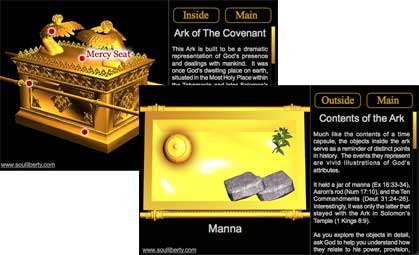
What I am not advocating here is a wordly approach to evangelism with focus groups, high-pressure marketing campaigns, and so on. There’s nothing wrong with advertising, however. Isn’t that what evangelism is anyway – advertising the Gospel far and wide? I’m also not arguing that putting a little more glitz into a website will have a direct impact on the visitor’s journey to salvation. I’m simply pleading for a higher standard. Give God your best each and every day in everything you do, and it will eventually rub off on others.
In this day of rapid change, when many Christians have suddenly started using one of the many modern English translations of the Bible (NASB, NIV, NEB, NRSV, NKJV, etc.), abandoning the long-used King James Version read and loved by English-speaking people of all ages and walks of life for over ten generations, it may be appropriate to review a few of the reasons why many creationists, including this writer, still prefer to use the latter.
Grady on Ruckman
According to his detractors, Peter Ruckman is guilty of: plural marriages, being mean-spirited, stealing money from gullible followers, racism, Nazism, and an attempted assassination plot. Whatever the personal sins of this man, his true crime in the eyes of the world is that he openly professes to believe the King James Bible word-for-word. Watch how one Christian man responds to this topic in a fresh way.
This high-quality, visually engaging presentation by Mark Spence, the Dean of the School of Biblical Evangelism, gives clear reasons why the Bible can be trusted as inerrant, inspired, and infallible.
If our universe and life on Earth didn’t evolve through natural forces, what did happen? Kent Hovind explains the Bible’s historical account and backs up his faith with sound reason.
Kent Hovind explains the biblical account of humanity’s beginnings and answers common objections to this history.
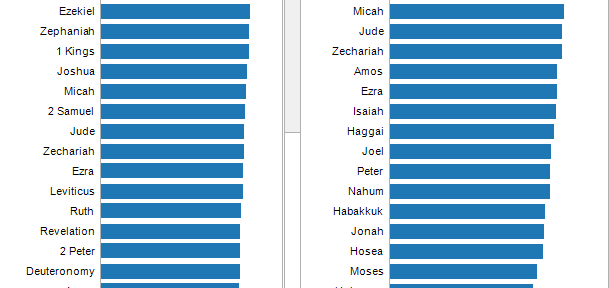
There are numerous claims about the readability of various English Bible translations. The chart below is the result of my own calculations using the standard Flesch-Kincaid grade level formula. Many other readability calculations do not specify whether sentence lengths are based on punctuation or verse divisions. This tool allows you to see it either way. In some sections, the results are wildly different.
This tool also makes it easy to find readability levels for each author, book and chapter (on the advanced tab), unlike the more general readability comparisons you may have seen already. Due to copyright restrictions, it is difficult to obtain electronic versions of the entire text of translations other than the KJV, so at the moment we do not have a simple tool available for comparing readability accross different versions.
(chart may take a moment to load)
Review: RefTagger vs. VerseClick
For novice bloggers and advanced web programmers, there are two good tools available to automatically create a pop-up showing the text of Bible verses referenced on your site, as in: Rom 1:20. One is RefTagger from Logos Bible Software. The other is VerseClick, recently made available at AV1611.com. If you are interested in using a tool like this, here are some things to consider.
UPDATE: after writing this review, I learned of the BLB ScriptTagger from the Blue Letter Bible website. It is well worth considering along with the two mentioned here.
RefTagger
Highly customizable: If you know some basic web concepts like CSS, you can match the styles in the pop-up window to your own site theme. There is an optional toolbox to allow visitors to choose their preferred translation or web developers can choose the default version using the simple setup form. There are many other options shown on the RefTagger website.
Works with most syntax: There are all kinds of ways to reference Bible verses, making it difficult for a computer to properly recognize them. RefTagger works with most common syntax and it also works with some developing web standards such as BibleRef markup.
Integrates with Logos Software: Next to each verse link, you’ll see an icon that takes the user to that verse within Logos Bible Software, provided the user has this software on their computer. To me, this is an unnecessary distraction. Few users are likely to want this feature and it adds a button that gets in the way of the normal flow of reading. It undermines the very purpose of the tool: to provide a seamless way to look up verses referenced without distracting the reader with a quote box or going to another resource in the middle of a paragraph. UPDATE: I am told that this feature is optional (see comments), but it is enabled by default and may be difficult for the average blogger to disable.
Performance and Simplicity: It is quite simple to install this tool on any site. Just pick a few options and paste a line of code in the appropriate place. Unfortunately, its host of options slows down page loading. While it performs adequately in most cases, it could be much better in my opinion.
VerseClick
Not customizable: Perhaps later versions will allow for some options regarding colors and fonts, but right now you’re stuck with a brownish-yellow background on the pop-ups. That said, the lack of custom parameters makes VerseClick perform much better in general than RefTagger (based on my experience – I don’t have the resources to do scientific benchmarking). Furthermore, it does not advance the proliferation of corrupt Bible versions so overall I view this as a “plus.”
Works with most syntax: Like RefTagger, most reference methods are supported. It doesn’t recognize BibleRef markup, which is how RefTagger recognizes whole-chapter tags. VerseClick takes you to the whole chapter when a verse is clicked and since both tools limit pop-ups to just a few verses, this becomes a moot point.
Performance and Simplicity: As mentioned, I have found VerseClick to perform better overall than RefTagger. It is just as simple to install and use: one line of code to cut-and-paste.
If you aren’t using either of these on your Christian website, I highly recommend adding this functionality for your visitors. It puts Scripture at their fingertips within whatever point the author is making. I use VerseClick for its use of only the time-tested KJV which ensures the verse shown is an accurate and complete translation, as well as for its superior download performance and absence of the distracting Logos button. The color styles of VerseClick happen to match the ones used on SoulLiberty.com, but if you find the yellow clashes with your design, I’d recommend e-mailing the creator to request the option to customize the CSS.
Playing with word clouds

A lot of bloggers are using word clouds for various features now, mainly to make common post tags stand out. I happen to think it’s a fad. Like Microsoft’s WordArt, it can do some nifty things but doesn’t really rise to the level of artwork that would be required for a valuable design aesthetic.
That said, it can be fun to play around with these ideas to see just how far you can go or perhaps lead to a better idea later. In that spirit, I present to you my word cloud made using Wordle and the text of the KJV (with words like thee, thou, ye, etc. removed).
Analyzing Cross References
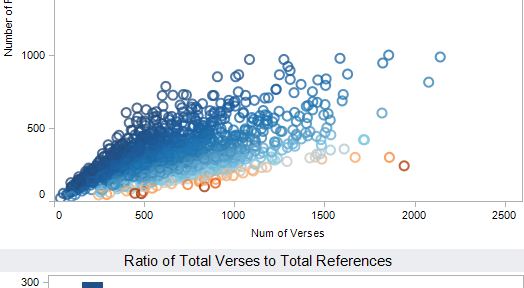
The Christian scriptures are interconnected in deep and meaningful ways which can sometimes be hard to discover. Scholars have compiled hundreds of thousands of cross-references over time, and modern computer whizzes have charted these references in beautiful and engaging displays. I have taken a new approach, which you can see below. It displays three measures: the number of verses in each chapter, the number of cross references in each chapter, and the ratio between the two.
In a moment I will share a few examples of the insights this visualization affords, but first I’ll explain how I arrived at the idea for making this particular interactive tool. I began working several months ago to compile available data into what I call MetaV. The eventual goal is to link descriptive information to every word in the Bible and to help users interact with it in such a way that they can see the “big picture” of any passage, including people, places, things, and even cross-references. Naturally, this led me to google “bible cross reference data.” Hit #1: Chris Harrison’s visual showing over 63,000 references with colors indicating the canonical distance between the chapters and bars showing the length of each chapter.
Immediately, I was hooked on it. I’ll confess: it still graces the background of my computer desktop. The reason I was so mesmerized is that he has packed a lot of information into a display that is simple at first glance then grows more complex and informative as you zoom in. It conveys the fact that the Bible is an interconnected whole. The density in some areas gives a general sense of which books may be interesting to us because they were meaningful enough for many other books to refer to it. And that nice, long, thin line towards the middle representing Psalm 119 just begs for attention while happily providing an axis of symmetry. It is art that fulfills it designer’s stated goal:
…we set our sights on the other end of the spectrum –- something more beautiful than functional. At the same time, we wanted something that honored and revealed the complexity of the data at every level –- as one leans in, smaller details should become visible.
Mr. Harrison was kind enough to get me in touch with his collaborator, Christoph, who in turn provided the data behind the graphic (which had been updated to include over 80,000 records). Yet, I was also aware that this many cross references might not be enough for me. Further searching brought me to two more visualizations of a much larger data set – over 340,000 cross references. The first is from OpenBible.info, the same site which is the source for my Bible Places explorer. The second is found on the ESV Blog. Both of these are interesting in their complexity and verse-level detail, which adds a degree of information not contained in Chris Harrison’s work. However, they both have a lot of redundancy – one could easily cut the visuals in half and get just as much information.
All of these are more useful in terms of artwork than for visual analysis and in-depth exploration. My expertise is in crunching numbers, not so much in making beautiful displays of them. I wanted to modify the idea of graphing hundreds of thousands of pieces of information in a way that makes certain aspects of it stand out. Just to make it a challenge, I combined the two data sets I found into one massive table containing 412,100 references once I filtered out duplicate records. The outliers you see above are chapters of the Bible which stand out here but would be lost in the haystack within the visualizations I’ve mentioned. While mine is nothing more than an interactive version of common graphical displays, it makes it easy for our eyes and minds to identify interesting points.
Right away, you can see that Psalm 119 lies lonely at the top-right because it is by far the longest chapter of the Bible and consequently has the most cross-references related to it. The orange circles stand in contrast because they have proportionately fewer cross references than other chapters. We might expect those to be the ones which are nothing more than long, detailed genealogical records. Two of the noticeable outliers fits that expectation (1 Chronicles 7&8) , but the others do not.
1 Chronicles 3, the brightest orange circle, is the chapter which details the construction of Solomon’s Temple. Exodus 36&37, two other orange marks, give specifics about making the Tabernacle and the Ark of the Covenant. The dimensions and construction materials of these things are rife with metaphors. Perhaps their symbolism is linked to other portions of scripture in ways we do not yet know an have not catalogued, or maybe they should continue to stand alone due to their uniqueness. On the other end of the spectrum, Romans 12 has more cross references for each verse than any other chapter. When you read it, you’ll understand why. On average, every single verse has more then one reference associated with it. In all, 77 chapters of the Bible fir in that same category.
These are just some of the things that can lead a student of the Lord to discover more about him. We can search out the things we may normally pass over but which stand out in an analysis such as this. What can you find by searching through, selecting, and zooming in on these plots? What might you learn that you would otherwise overlook? Please leave a comment if you happen upon something interesting or the Lord blesses you in some way as a result of your studying these visuals.
